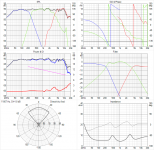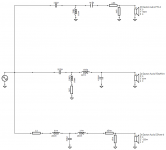Hi
The DIY speaker bug got into me about two year ago and, unfortunately, the more I read, I felt that the less I knew... Now with far too much time on my hands, I decided to give it another go. Yes, I understand that a 3 way speaker is much more difficult to develop and I would be better off with just buying a kit, but where is the risk in that 😀
Drivers used:
Dayton Audio DSA315-8 12" Designer Series Aluminum Cone Woofer
Dayton Audio RS52AN-8 2" Reference Aluminum Dome Midrange
Dayton Audio PT2C-8 Planar Tweeter
I tried to maintain a flat curve and an overall impedance over 4/5 ohms (my past attempts would just dip to 2 ohms or lower).
What I do not understand:
a. Regarding the phase graph.. Are the vertical lines supposed to overlap in order for the drivers to be in phase (I assume in phase electrically, as they can be out of phase depending on how I place them on the baffle)
I was hoping I could have your opinion regarding the crossover/ the feasibility of my design.
Thank you
The DIY speaker bug got into me about two year ago and, unfortunately, the more I read, I felt that the less I knew... Now with far too much time on my hands, I decided to give it another go. Yes, I understand that a 3 way speaker is much more difficult to develop and I would be better off with just buying a kit, but where is the risk in that 😀
Drivers used:
Dayton Audio DSA315-8 12" Designer Series Aluminum Cone Woofer
Dayton Audio RS52AN-8 2" Reference Aluminum Dome Midrange
Dayton Audio PT2C-8 Planar Tweeter
I tried to maintain a flat curve and an overall impedance over 4/5 ohms (my past attempts would just dip to 2 ohms or lower).
What I do not understand:
a. Regarding the phase graph.. Are the vertical lines supposed to overlap in order for the drivers to be in phase (I assume in phase electrically, as they can be out of phase depending on how I place them on the baffle)
I was hoping I could have your opinion regarding the crossover/ the feasibility of my design.
Thank you
Attachments
You want them in phase through the crossover region. The test for this is to reverse one driver (the midrange here) and see if you get deep, wide nulls. This ensures the best blending from driver to driver.
I'd say you want to be flat to downward sloping, you are just a teensy bit going upwards.
Also, remember to include baffle step in your woofer measurements.
I'd say you want to be flat to downward sloping, you are just a teensy bit going upwards.
Also, remember to include baffle step in your woofer measurements.
I know that was not the question but imo the midrange to woofer crossover point is a little low, considering this is a 2" midrange with 1mm xmax.
For phase matching, look at this blog post, which has Xsim files:
A Speaker Maker's Journey: LM-1 Bookshelf Crossover
and look near the bottom for two charts on this subject.
A Speaker Maker's Journey: LM-1 Bookshelf Crossover
and look near the bottom for two charts on this subject.
It might help you to have a look at this design from Zaph Audio which uses the same mid dome.
Zaph|Audio - ZDT3.5
Zaph|Audio - ZDT3.5
You need a bigger midrange, going from a 12" woofer to a 2" mid is not optimal.
Don't forget to compensate for BSC.
Don't forget to compensate for BSC.
You need a bigger midrange, going from a 12" woofer to a 2" mid is not optimal.
Don't forget to compensate for BSC.
Agreed ... I would think you'd want at least a 3.5 or 4" midrange in there.
Also ... if you can transfer your crossover design into XSim, I'm sure you'd get quite a bit of feedback on it...
In order to see this more clearly, invert the phase of all three drivers.Are the vertical lines supposed to overlap in order for the drivers to be in phase
I don't think you really want that 2.2 ohms in series with the woofer, and the "lpad" just before it as well.... I'm guessing you haven't factored baffle step into the woofer response before modeling?
Tony.
Tony.
What Tony said. In a speaker the overall sensibility is dictated by the woofer, the other drivers have to be more sensitive than the woofer, and padded down accordingly.
I'm not saying you did that, but the two main errors done when importing frd and zma files into a crossover simulator are:
not simulating baffle step and diffraction effects,
non calculating driver offset, or to be more precisely the voice coil offset.
The first error leads to an overestimate of the woofer SPL, whereas the second leads to an incorrect summation of the drivers' output, something that is not marginal in the mid-tweeter transition. I've never worked with a dome mid so I don't know if this would be a problem here, but with a 6.5" driver crossed to a tweeter the driver offset is more than 1".
After simulating the baffle step and diffraction effects you have to recalculate minimum phase, and only then you are ready to simulate a crossover.
Ralf
I'm not saying you did that, but the two main errors done when importing frd and zma files into a crossover simulator are:
not simulating baffle step and diffraction effects,
non calculating driver offset, or to be more precisely the voice coil offset.
The first error leads to an overestimate of the woofer SPL, whereas the second leads to an incorrect summation of the drivers' output, something that is not marginal in the mid-tweeter transition. I've never worked with a dome mid so I don't know if this would be a problem here, but with a 6.5" driver crossed to a tweeter the driver offset is more than 1".
After simulating the baffle step and diffraction effects you have to recalculate minimum phase, and only then you are ready to simulate a crossover.
Ralf
Except that baffle effects are generally not minimum phase.After simulating the baffle step and diffraction effects you have to recalculate minimum phase,
I disagree, if diffraction is being simmed then the phase nature should be able to be retained. If it wasn't so then I'd question the need to reset it to min. As to it's appropriateness in a crossover, well diffraction is a bit of a compromise whichever way you slice it.
Ok, so you mean make sure the original before diffraction sim has been added has been converted to minimum phase, and then do the adjustment for baffle step effects and use as is..
This is assuming that the original is a traced manufacturer's curve 🙂
It's been quite a while since I did something like this and I don't remember which way around I did it!
Tony.
This is assuming that the original is a traced manufacturer's curve 🙂
It's been quite a while since I did something like this and I don't remember which way around I did it!
Tony.
Yes.
Speaking of assuming, this does assume a lot. A diffraction simulator is likely to calculate the delay of a secondary source, then convert that into phase before adding it to the direct sound. This is still a considerable simplification.
The only way to be sure is to reduce the diffraction as much as possible acoustically.
Speaking of assuming, this does assume a lot. A diffraction simulator is likely to calculate the delay of a secondary source, then convert that into phase before adding it to the direct sound. This is still a considerable simplification.
The only way to be sure is to reduce the diffraction as much as possible acoustically.
- Home
- Loudspeakers
- Multi-Way
- Opinion on a first 3 way crossover

